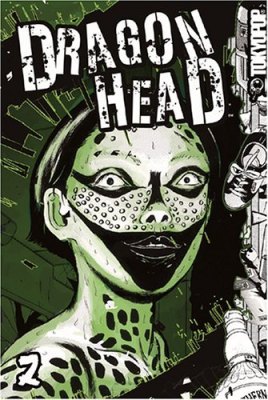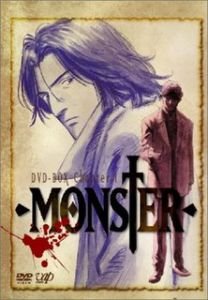It's The End Of The World As We Know It:
Post-Apocalyptic Manga
by McCamy Taylor

The
three titles I review this
month -- Dragon Head by Minetaro
Mochizuki, King of Thorn by Yuji
Iwahara
and Monster
by Naoki
Urasawa --
share something in common. All three are tales about the end of one
world…and
the start of a new one.
In
Joseph Campbell’s formula for
heroic fiction, The Hero With 1000 Faces the
protagonist
begins his
epic journey by going “Into the Belly of the
Whale”, i.e. by losing the world.
As Campbell describes it, “the passage of the threshold is a
form of self
annihilation.” A hero can not transform, unless he casts off
his old
world---and old ideas. This triggers a search for a new identity.
Dragon Head starts
with
a mystery. What kind of disaster has left a group of schoolchildren on
holiday
trapped in a train in a tunnel? Did Mount Fuji erupt, spewing black ash
over
Japan and plunging the world into a volcanic winter? Did a meteor
strike the
earth? Did an apocalyptic cult set off nuclear bombs? It is natural for
the
readers to ask these and other questions as the story progresses.
However, the
author’s primary goal is not to tell us what
happened. By
concentrating on the experiences of a teenaged boy and girl who are
trying to
get back home to their families in Tokyo, Minetaro
Mochizuki turns
a classic science fiction story into a
very gritty, realistic horror tale, in which characters struggle to
survive in
a world gone mad. This is a story about fear and its effects on people.
There
are a few heroes, who discover previously unsuspected strength. There
are some
villains. There are many more who are simply victims searching
desperately for
some way to adapt to the new, post-apocalyptic Japan. The
strength of this story is the mangaka’s
ability to create a fully realized nightmare world and populate it with
flesh
and blood characters. By the end of this ten volume series, you may
have some
questions about what happened, but you will be absolutely
certain that
you know how it felt being there. Available in English from Tokyopop.
There is
also a live action film based upon this title.

For
those who absolutely must
know what happened as well as the results, King of Thorn is a more traditional
science fiction story.
However, it is similar in many ways toDragon Head. A
school
girl
suffering from a deadly, incurable viral infection is put into
cryogenic sleep
along with others, who have been selected by a lottery. The goal is to
reawaken
them when a cure has been found. The girl’s twin sister, who
also suffers from
the disease, is not among the chosen. However, since this is an
“end of the
world” tale about new identities, the reader knows that she
will figure into
the later story.
Time
passes and the sleepers
wake to find that the research
facility has been destroyed and taken over by monsters. A handful of
survivors
attempt to reach safety and find a cure for their affliction. As with
most
tales of this type, the demons they battle are internal as well as
external---and as the story unfolds, we learn that the line between the
two is
very thin indeed. The
six volume manga
is also available in English from Tokyopop. An anime adaptation is
planned for
next year.
Sometimes
change that is not so
obviously catastrophic can turn the world upside down. That is what
happens in
the next story, which is set around the time of the fall of the Berlin
Wall and
the end of the Cold War. Monster,
by the
mangaka of 20th Century Boys
and Pluto,
starts with a simple premise. A Japanese neurosurgeon working in
Germany saves
the life of a boy who turns out to be a “monster”
bent upon destroying the
world. Once Doctor Kenzo Tenma realizes what he has done, he sets out
on a
journey to correct the mistake he has made. His task is made more
difficult by
the fact that the “monster”, Johan, has framed him
for murder. Think The
Fugitive. Tenma has been stripped of everything he
valued---his
career,
his reputation, his fiancé. Now, it is up to him to recreate
himself.

Dr.
Temna’s sense of
responsibility for the crimes of Johan may seem a little bit
exaggerated if you
consider them as just two random characters in a story. What doctor
would fail
to perform surgery on a critically wounded boy, even if he knew that he
might
grow up to be the next Hitler? However, context counts.
The tale is a
metaphor for Japan’s guilt over WWII and especially its
alliance
with Nazi Germany. The story’s main tension is between the
human tendency to
call other people “monsters” and the equally strong
impulse to treat others
with compassion.
This
series is long for a
reason. In addition to the main story involving Tenma and Johan, there
are
subplots about many of the people the doctor meets on his journey. And
the
story of Johan’s origins is a complicated one, which involves
the Cold War, eugenics
and psychological experiments on children. As
usual, Naoki
Urasawa’s characterizations are first
rate. Though his drawing style is simple, he pays attention
to facial expressions. This, combined with his
writing creates
characters every bit as
vivid and memorable as those of Charles Dickens.
In its breadth and scope, the story is a lot like Dickens,
too.
You will come away convinced that the people, places and events of the
story
are absolutely real---which is the most important task for a writer of
speculative fiction .The
18 volumes in this series are available in English
from Viz, and there is also a 74
episode anime based upon this story.
© 2009 McCamy Taylor
McCamy Taylor is Aphelion's current Serials and Novellas Editor (if you have a story longer than 7,500 words, or long enough that it would be suitable for publication in two or more installments, she's your girl... er, woman), author of many short stories and longer fiction, here and in other publications, and is now Aphelion torchbearer for the cause of Japanese graphic novels and animation.
Comment on this story in the Aphelion Forum
Return to Aphelion's Index page.
|




